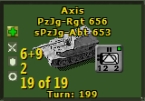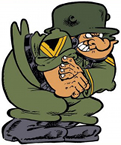ColinWright
Posts: 2604
Joined: 10/13/2005
Status: offline

|
quote:
ORIGINAL: Curtis Lemay
quote:
ORIGINAL: ColinWright
Many of the other proposed naval changes sound good, but those under the 'revolutionary' section don't.
"9.16.1 Ships would be subject to damage. This would cause reduction in capability as appropriate. It would require repair. Sinking would be caused by 100% damage only. Naval units would not “evaporate” as land units do. They would only be eliminated if all ships in them were “sunk”. Damaged ships would not be returned to the pools – they would have to get back to port under their own power, debilitated by whatever damage they had incurred."
This seems to me to be entirely misconceived. In the scale and time frame OPART deals in, it's practically the opposite of reality. Take Crete: only a quarter or so of the Mediterranean Fleet was literally sunk -- but another two quarters was so damaged as to be unserviceable for various lengths of time.
Destroyers leaking from near misses can't put to sea again with reduced efficiency -- they have to dock and be repaired, or they'll sink. They're out, or they're in. Rarely are they coming back out of port but with only half of their original fighting strength.
The current system actually handles this about right. In OPART terms, all three-quarters of the Mediterranean fleet would be 'sunk' off Crete. Then the replacement engine will reluctantly dispense about half of the losses back over time.
And that's about what happened. A quarter were sunk for good, another quarter were so badly damaged as to be out of service for the duration of any reasonable TOAW scenario, and the third quarter were indeed repairable over the next few weeks or so.
In general, the whole thing seems to suffer from attempting to take a tactical approach to what is, after all, an operational level game ('Ships can have a secondary armament – with different range and shell weight from main armament...9.16.2 Modeling of catastrophic hits that detonate magazines.').
Sorry, but it's my guess that all this should be junked. If not junked, at least make it optional. It'll make matters worse rather than better. Get a stand-alone tactical naval game if that's what you want. This is like trying to make OPART do your taxes. It's not the right engine for the application.
Right. Like such "tactical" games as WitP and PacWar.
You may or may not have a point -- how things work in WitP and PacWar, how valid they are as simulations, and how these mechanisms fit into the general structure of the game I couldn't say. I will observe that I don't have your apparently unwavering faith in the validity of these simulations -- and I doubt if closer inspection would change that. I've never seen any simulation that was completely valid. They all almost necessarily fall short. What varies is by how much they fall short.
However, the gist of what I posted is that the changes you propose, in TOAW, would seem to produce effects just the opposite of what happened in reality. A lot of it revolves around realizing that ships lost in TOAW aren't necessarily sunk -- they're just removed from play, some of them permanently, some of them temporarily. That is, in fact, what tended to happen -- at least off both Crete and Norway. How many ships are rendered hors de combat for a while and how many are actually sunk are two very different things. The battle report says you lost four destroyers. It doesn't say they're sunk. In reality, of course, the destroyers Kimberly and Kashmir have indeed gone to the bottom, the Khyber is going to be out for a while on account of its bow having been blown off, and the Kwaanza merely has some loosened rivets and buckled bulkheads and will be back in a few weeks. The game engine allows for that. Half your losses will go into the pool, and depending on what replacement priority you set for the unit, will trickle back in sooner or later. It's one of the few aspects of the current naval model that actually works passably well.
A key question is whether all this (the 'revolutionary' changes)is going to be a designer option -- or is it going to be something players will have to accept?
In any case, it wouldn't actually be something that would ruin the game -- naval warfare in TOAW is fundamentally misconceived anyway, and whether the essentially marginal changes you propose will make things slightly better or slightly worse is an interesting but hardly critical issue. I have little doubt that if you're determined enough, you'll have your way over this.
If I'm going to win any argument here, it'd be the one over making terrain effects cumulative for movement and combat. That would pose some vexing problems -- and it would seem to violate your own stricture against making any changes that would damage those scenarios that are already in existence.
< Message edited by ColinWright -- 4/25/2012 8:06:08 PM >
_____________________________
I am not Charlie Hebdo
|
 Printable Version
Printable Version









 New Messages
New Messages No New Messages
No New Messages Hot Topic w/ New Messages
Hot Topic w/ New Messages Hot Topic w/o New Messages
Hot Topic w/o New Messages Locked w/ New Messages
Locked w/ New Messages Locked w/o New Messages
Locked w/o New Messages Post New Thread
Post New Thread